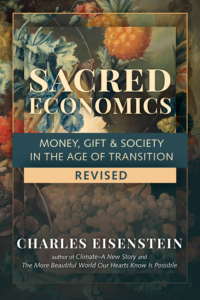Climate — A New Story
Chapters
Chapter 12: Bridge to a Living World
Bridge to a Living World
Knowing the depth of the initiation upon us, where do we go from here in practical terms? Without a bridge from the realm of metaphysics to the world of policy, we risk making the Story of Interbeing into a mere philosophy.
Such a bridge must span a great gulf. Notions like “the voice of the land” seem positively ridiculous in the context of current public policy conversations.
On one side of the gulf are the solutions that are necessary for the timely healing of Earth. Visiting that territory, one feels tremendous hope. Earlier this year I visited the Occidental Arts & Ecology Center, headed by the brilliant and loquacious Brock Dolman, where I saw first-hand the practices that could quickly reverse the course of global ecocide. The multistoried agroforestry, the native species restoration, the water retention features, the composting toilets … none of these are unrealistic fantasies. There they were, in front of my face. At that moment, I knew that my heart’s foretelling of a more beautiful world coincides with an actionable reality.
On the other side of the gulf are dominant practices, policies, and perceptions. Real as a more beautiful world seems while I’m at the OAEC, inevitable as it seems when I tune in to Brock’s knowledge and intelligence, the OAEC is after all the fringe of the fringe. Permaculture principles practiced there for thirty years are not even a twinkling in the eye of the Secretary of Agriculture. Its budget is less than 0.001 percent of the budget of the agricultural-industrial complex. As this book has argued, most of the responses visible on the progressive radar—such as commercial organic agriculture and renewable energy—are still deeply conventional, freighted with beliefs and practices that contribute to the problem.
Nonetheless, the gulf between these two worlds is shrinking, thanks to the movement of the tectonic plates—the myths, values, and unconscious agreements—of our civilization. As they shift, formerly unrealistic proposals drift to within a bridge-span of practicality. Yes, the measures I will summarize in this chapter still seem wildly impractical at the present writing; I present them anyway, for three reasons: (1) the collective mind is ready for them to move from the “fringe of the fringe” to the mere fringe—poised to infill the policy vacuum that follows crisis and catastrophe; (2) many of them do not require broad social consensus or institutional endorsement to be practiced on a smaller scale right now by innovators, philanthropists, and landowners; (3) nothing less than these will suffice. Why bow to a “practicality” so narrow that it is tantamount to no change at all?
Here are some of the policies and changes that are necessary over the next couple decades if we are to change course and move toward a living world rather than the Concrete World of chapter 7. Most of them are obvious corollaries to the themes of this book; I will leave two for the end that require some explanation as to why they are so crucial for planetary healing. I am leaving out important reforms like ending mass incarceration or implementing universal basic income that have only indirect (albeit powerful) long-term ecological benefits.
- Promote land regeneration as a major new category of philanthropy: fund demonstration projects, connect young farmers to land, and help farms transition to regenerative practices. Provide public funding and government support for this transition as well by shifting agricultural subsidies away from conventional crops.
- Institute a global moratorium on logging, mining, drilling, and development of all remaining primary forests, wetlands, and other ecosystems.
- Expand the land protected in wildlife refuges and other reserves. When possible, enlist local and indigenous people in protection efforts to align their livelihood with ecological health.
- Establish new ocean marine reserves and expand existing ones, with the goal of placing a third to half of all oceans, estuaries, and coastline into no-take/no-drill/no-develop sanctuaries.
- In the rest of the oceans, establish strict bans on driftnets and bottom trawling.
- Ban disposable plastic bags for retail purchases. Phase out plastic beverage containers in favor of a refillable bottle infrastructure.
- Reconstitute the World Bank to serve ecological healing rather than development. Start by declaring the Amazon and Congo rainforests global treasures, purchasing the external debt of countries where the rainforests grow, and canceling the debt at a rate equivalent to the potential income from now-banned logging, mining, and drilling in those areas.
- Promote afforestation and reforestation projects globally with an emphasis on ecologically appropriate native species.
- Establish an “eco-corps” to address youth unemployment and restore ecological health by planting trees, building water retention features on public land, deconstructing dams, etc.
- Change building codes, sanitation codes, and zoning regulations to allow higher density development, tiny homes, composting toilets, aquaculture wastewater treatment, etc. Nullify all land use covenants that prohibit vegetable gardens.
- Reintroduce and protect keystone species such as (in North America) beavers, wolves, and cougars.
- Carry out water restoration projects worldwide through water retention landscapes (swales, ponds, check dams, etc.), regenerative grazing and horticulture, and the strategic removal of dams, canals, and levees.
- Relocalize the food system and promote economic localization generally, first by nullifying free trade treaties and replacing them with “fair trade treaties” that protect local economic sovereignty.
- Institute a negative-interest financial system through international agreement to impose liquidity fees on bank reserves, along with complementary measures such as Georgist land taxes and other anti-speculative taxes.
- Apply pollution taxes to make companies internalize the social and ecological costs of toxic waste, radioactive waste, air pollution, and water pollution.
- Impose a deposit system for most manufactured goods so that manufacturers have an incentive to create durable, repairable products with easily recoverable materials.
- Turn away from pesticides.
In the conventional climate narrative, pesticides are virtually irrelevant to the fate of the biosphere. Not so in the living planet narrative.
In chapter 3 I referenced the ongoing insect holocaust, a term I do not apply lightly. From Europe to Australia to the Americas, insect biomass is in precipitous decline, a phenomenon that many scientists attribute to the growing use of insecticides over the past eighty years. Of particular concern are the notorious neonicotinoids, the most heavily used insecticides today. Because they are generally long-lived, these chemicals permeate the environment, showing up in plant nectar, pollen, groundwater, and soil.
Except in the case of honeybees and other pollinators, there is no direct proof that these are responsible for the insect holocaust, which in some areas approaches 90 percent (in terms of biomass decline). The scarcity of evidence is not surprising given that most research is funded by the same companies that manufacture the insecticides. Furthermore, current research methods are geared toward identifying monocausal phenomena, but insect decline is probably due to multiple, synergistic causes, including habitat disruption, soil degradation, drought, and other forms of chemical pollution. Yet for the insects, surely insecticides are the lynchpin.
Insects are a crucial part of nearly all food chains, as well as being instrumental in the life cycles of plants. Countless symbiotic relationships between insects and fungi, bacteria, worms, plants, and vertebrates maintain the web of life. Pesticides harm these other beings directly too, not only via their harm to insects. Aside from neonicotinoids, the other notorious pesticide today is the herbicide glyphosate, which also has pervasive ecological effects far beyond its time and place of application.
We have basically conducted an eighty-year experiment to see what happens to the biosphere when we constantly dump poison into it. Life is resilient, so the effects were hard to notice at first, but they have gathered now to critical mass.
To transition away from pesticides entails the wholesale deindustrialization of agriculture, in particular the ending of monocropping. The transition cannot happen overnight, but it needs to start now, and on a massive scale. What can happen overnight would be to ban completely the use of pesticides for nonagricultural use: lawn chemicals, garden insecticides, glyphosate used in city parks, etc. Aside from forest and wetlands destruction, pesticides might be the most urgent environmental issue we face. Insect decimation is no joke. Insects are life at nearly its most basic; they are fundamental tissues of the living planetary body. If we want a living planet (with, among other things, a healthy climate), we have to hear the message in the die-off and do something about it right now.
- Demilitarize society.
As the saying goes, you cannot serve two masters. When a person or a society serves two conflicting aims, eventually the contradiction will rise to the surface in the form of a choice point, a crossroads, or a clarifying test.
What overarching aim does the military serve? Traditionally it was the interests of the nation-state; today it might be more the interests of transnational capital. On a deeper level, it serves the paradigm of domination through force. Demilitarization is therefore a necessary marker and sign of a civilizational shift of priorities. In a war, the top priority is the defeat of the enemy; anything else may need to be sacrificed. In a war, a country won’t let environmental considerations interfere with bombing oil wells, pipelines, factories, and so forth. The air force won’t limit its bombing runs to conserve fossil fuels. The army won’t curtail its use of depleted uranium munitions for fear of contaminating groundwater. They are serving another master—something else comes first.
The environmental crisis invites us to change our priorities and put earth healing first, make ecological-social healing the primary conditioning parameter on every political decision. The military mind puts defeat of an enemy first instead. More tangibly, the military sucks up prodigious amounts of energy, materials, money, and human talent. Tens of thousands of the best scientists and engineers devote their lives to developing weaponry. Millions of healthy, capable, idealistic young people join the military. And of course, the money squandered on weaponry is enough to fund probably all of the other proposals in this book.
Representing an enormous commitment of human effort, the military is the concrete expression of an aim—well-being and progress through domination—that itself arises from the defining story of Separation. Demilitarization signals a profound shift in priorities as well as in the story underlying them.
Just as in personal life, psychological change requires concrete action in order to seem and be real. Demilitarization—closing down bases, retooling armaments factories, retraining troops, etc.—is a collective ritual demonstrating to the collective mind that everything is different now.
Rather than quantify the resources and energy that demilitarization would free up, I will just appeal to your intuition that we face a crossroads. War or peace? Love or fear? Domination or service? We are not going to see real earth healing while maintaining the military-industrial complex. If we want to live in a more beautiful world, we will have to give up central aspects of business-as-usual. What could be more starkly relevant a first step than demilitarization?
Note that I have not included a carbon tax among these proposals. The reasons are: (1) large reductions in fossil fuel use will necessarily result from establishing vast new marine sanctuaries and forest conservation zones, and from various pollution taxes and watershed restoration projects; (2) regenerative agriculture and reforestation will sequester large amounts of carbon; (3) carbon taxes create perverse incentives for things like large hydroelectric facilities and biofuels plantations that destroy ecosystems. This book has argued that while high levels of greenhouse gases add stress to an already challenged biosphere, the main problem is the impoverishment of life and the degradation of the water cycle. But even if I am wrong, the measures I have described will achieve carbon drawdown without making carbon the primary framing issue.
These measures are much more ambitious than merely shifting to carbon-neutral energy. I was about to say that they aren’t going to “happen overnight,” but let us not hold to that expectation too tightly. The process of change often includes long periods of apparent stasis, during which invisible substructures are shifting even as the visible superstructures look stronger and more permanent than ever. In fact, they are like a termite-ridden building that can indeed collapse overnight.
Even so, many of the changes make sense only from the ground of a new story. They will take time to germinate, blossom, and bear fruit. I applaud the urgency to act, but along with this urgency must come the patience to do things that take many generations to flower. We need to do some things that will bring quick results (many are listed above), but we also need to do things that will bring slow results. Which are yours to do? Are you excited to campaign for a plastic bag ban where you live? For a marine sanctuary? To stop a pipeline or fracking well? Or is your calling something that will take generations to have tangible ecological benefits? Is it maybe to work with trauma survivors? To aid refugees? To practice holistic midwifery? To be a mentor to at-risk youth? To raise children who carry a little less pain into adulthood than you did? These are the kind of things that enrich the cultural soil in which new paradigms and policies can grow. Furthermore, even though there is no clear, near-term causal through line from them to, say, watershed restoration or rainforest conservation, some part of me knows that they are indispensable. They are a declaration of the kind of world we want to live in; they are a prayer bringing us into alignment with a living world.
All of the policies and practices I have described are within reach right now. The vision of a Green World is not fantasy; nor, however, is it realistic. What it is, is possible. It requires each one of us to dedicate ourselves, unreasonably and with no guarantee of success, to our unique form of service. It requires that we trust our knowing that a healed world, a greened world, a more beautiful world is truly possible. I hope this book has amplified that calling and trued you to that possibility.






